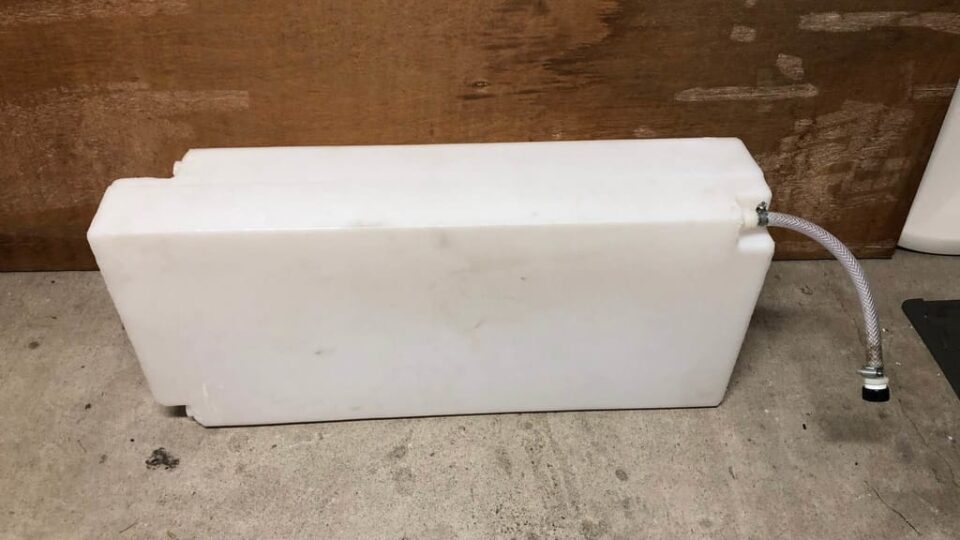Sailboat Water Tank Size
Similar to the gas tank, the water tank is also a vital component of your sailboat’s systems. A water tank can be used to hold wastewater, freshwater, and wash water. In other words, water tanks are your sailboat’s plumbing system and they supply water to the shower, galley, and even for electric toilets. Water tanks can be made of different materials like polyethylene, stainless steel, and plastic coated fabric. As for their position, they are usually safely situated somewhere inside the sailboat or they might also be portable. So, let’s see the characteristics and different uses for a water tank as well as its size.
General Info About Sailboat Water Tanks
Firstly, as we know water is heavy so it’s safer for water tanks to be situated low in the sailboat. But in case you want to add more water tanks, you’ll need to have a relatively large sailboat in order to provide some extra space. In the market, you can find many different sizes and shapes of rigid polyethylene tanks. A water tank normally has three threaded ports, one for the outlet, one for the vent hose, and one for the fill hose. Threaded hose barbs are used for hose connections. The inlet is connected to an on-deck fill and the vent line leads to a vent fitting high in the sailboat.
Keep in mind that if the vent is not higher than the fill, then it might overflow when you are filling the tank. Furthermore, remember that the outlet connection leads directly to a pump or to a manifold/Y-valve for a multi-tank installation. Finally, remember to secure hoses with stainless steel hose clamps.
Water Tank Position
Water tanks can be usually situated on each side of the sailboat or on its center in order to keep it balanced. When their location is on each side of the sailboat then they are connected together with a balance pipe of approximately 1-inch in diameter. This way both tanks are kept at the same level. Keep in mind that in case the balance pipe is small then it might take more time to fill in. This happens because the transfer of the water from one tank to the other is difficult to happen quickly enough. In fact, when the two tanks are situated at the same height then your sailboat has a balanced system that requires only a one-level indicator.
Water Tanks Materials
Different materials can be used to manufacture water tanks. These can be stainless steel, polyethylene, aluminum, and flexible fabric. When it comes to measuring the pros and cons of these materials, everyone has its own characteristics. For example, polyethylene water and waste tanks don’t usually retain odors, compared to tanks that are made out of stainless steel or aluminum. On the other hand, stainless steel tanks are less prone to rust or corrosion problems but their cost is relatively high than polyethylene tanks. As for their construction water tanks have baffles that prevent excessive movement of the water inside. However, the in-between spacing depends on their construction materials. For instance, a Tek-Tank polyethylene tank will have a baffle spacing of approximately 250mm and 350mm. But, a stainless steel water tank usually has fewer baffles with a spacing of 500mm.
Tank Fittings
The hose that is used in order to connect the fill point on the tank to the deck filler can be of two kinds. Either a green-tinted delivery hose or a clear braided hose. The vent pipe and feed have usually a very small diameter, around ½-inch. This diameter suits the best for pumps and deck fittings. As for the hose tails which are basically the fittings connecting to the hoses; they’re barbed so that the pipe won’t come off. Therefore, the hose is pushed into the hose tail and then tightened with a jubilee clip. You can also use thread sealant or Teflon tape on all threaded fittings. Moreover, remember not to overtighten fittings in plastic tanks.
Water Tank Size
Let’s now see some examples of water tank sizes on different types of sailboats:
- The Bavaria Cruiser 34 has a 39-gallon water tank capacity.
- The Hunter 32 Vision has a 50-gallon water tank capacity and the tank is located under the V-berth.
- The Catalina 310 has a 55-gallon water tank capacity
- The Beneteau Oceanis 51.1 has a 106-gallon water tank capacity, located under the berth in the forward cabin.
- The Sparkman & Stephens 52ft Yawl has 2 stainless steel water tanks installed beneath the saloon sole. Each one has a capacity of approximately 50 gallons.
- The Bavaria C45 has a 143-gallon water tank capacity.
- The Island Packet 38 has an aluminum 157-gallon water tank situated under the sole.
- The Amel 50 has a 160-gallon water tank capacity.
- The Hallberg-Rassy 64 has a 331-gallon water tank capacity.
Summary
The size of a water tank in a sailboat depends on different factors. Mainly, the model and type of your sailboat, its plumbing system as well as the tank’s materials, position, and construction. There is a wide range of sailboat water tanks available on the market for drinking water, wastewater, or where space is not enough, flexible water tanks. The most common materials are polyethylene, stainless steel, and aluminum. Moreover, there is a variety of shapes and capacities, ranging from 40 to 400 gallons. Keep in mind to drain water tanks of any waste or water when preparing your sailboat for off-season storage. Like this, you’ll prevent any unexpected damage by freezing temperatures. Last but not least, do not consider using any tank that is not easy to pump out.
